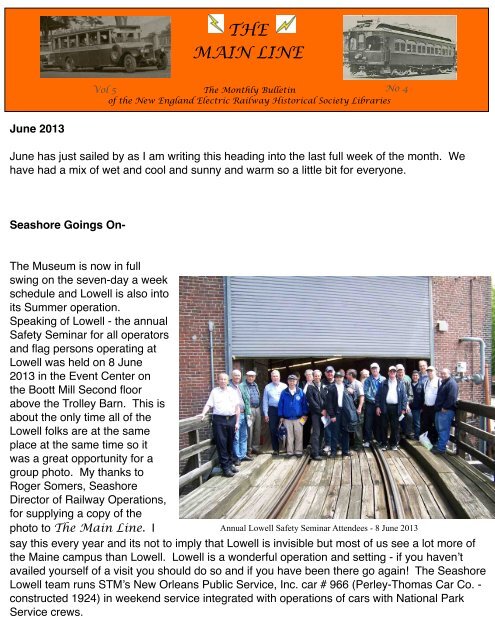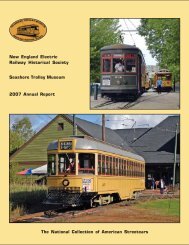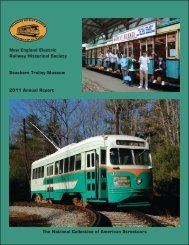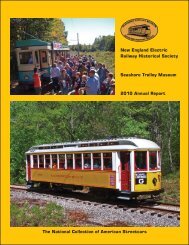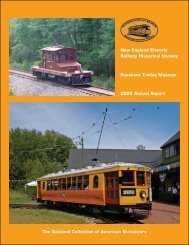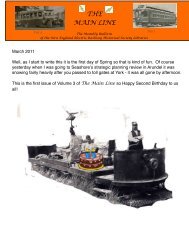June 2013 Main Line vol5 No4 - Seashore Trolley Museum
June 2013 Main Line vol5 No4 - Seashore Trolley Museum
June 2013 Main Line vol5 No4 - Seashore Trolley Museum
Create successful ePaper yourself
Turn your PDF publications into a flip-book with our unique Google optimized e-Paper software.
! THE !<br />
MAIN LINE<br />
! !<br />
Vol 5<br />
The Monthly Bulletin<br />
No 4<br />
of the New England Electric Railway Historical Society Libraries<br />
<strong>June</strong> <strong>2013</strong><br />
<strong>June</strong> has just sailed by as I am writing this heading into the last full week of the month. We<br />
have had a mix of wet and cool and sunny and warm so a little bit for everyone.<br />
<strong>Seashore</strong> Goings On-<br />
The <strong>Museum</strong> is now in full<br />
swing on the seven-day a week<br />
schedule and Lowell is also into<br />
its Summer operation.<br />
Speaking of Lowell - the annual<br />
Safety Seminar for all operators<br />
and flag persons operating at<br />
Lowell was held on 8 <strong>June</strong><br />
<strong>2013</strong> in the Event Center on<br />
the Boott Mill Second floor<br />
above the <strong>Trolley</strong> Barn. This is<br />
about the only time all of the<br />
Lowell folks are at the same<br />
place at the same time so it<br />
was a great opportunity for a<br />
group photo. My thanks to<br />
Roger Somers, <strong>Seashore</strong><br />
Director of Railway Operations,<br />
for supplying a copy of the<br />
photo to The <strong>Main</strong> <strong>Line</strong>. I<br />
Annual Lowell Safety Seminar Attendees - 8 <strong>June</strong> <strong>2013</strong><br />
say this every year and its not to imply that Lowell is invisible but most of us see a lot more of<br />
the <strong>Main</strong>e campus than Lowell. Lowell is a wonderful operation and setting - if you haven’t<br />
availed yourself of a visit you should do so and if you have been there go again! The <strong>Seashore</strong><br />
Lowell team runs STM’s New Orleans Public Service, Inc. car # 966 (Perley-Thomas Car Co. -<br />
constructed 1924) in weekend service integrated with operations of cars with National Park<br />
Service crews.
<strong>Seashore</strong> <strong>Trolley</strong> Dog Day -<br />
Back in the Pine Tree State on<br />
the same day as Lowell’s Safety<br />
Seminar was <strong>Seashore</strong> <strong>Trolley</strong><br />
Dog Day - a chance for canine<br />
visitors and their owners to have<br />
the opportunity to ride the rails<br />
together. There were also<br />
demonstrations of specially<br />
trained dogs, dog related<br />
organizations and good food.<br />
There were an amazing number<br />
of dogs and owners who came for<br />
Matt With Peppermint the event. <strong>Seashore</strong>’s own Matt<br />
" " " " Cosgro had a particular hit on his<br />
" " " " hands with Peppermint.<br />
A Future In Steeplechase?<br />
Creatures Large and Small - Really Large and Really Small<br />
A very interesting day and fun for all involved.<br />
One of the working dogs and his associates visit with Bill Pollman<br />
Railroading Merit Badge Program<br />
I was at <strong>Seashore</strong> on 22 <strong>June</strong> <strong>2013</strong> to receive a donation of materials for the Library - more<br />
below on that - and there were several dozen boy scouts working on their railroading merit<br />
badges. Extra cars and crew were on hand to support this effort.<br />
Boy Scouts of America Railroading Merit Badge Program
Boy Scout troops from all over the region come to the <strong>Seashore</strong> <strong>Trolley</strong> <strong>Museum</strong> for a weekend<br />
to learn about the parts of a railroad, from jobs and safety to the infrastructure that allows the<br />
railroad to run. Normally scout troops earn their Railroading Merit Badge individually and<br />
usually with a model railroad. The <strong>Museum</strong> provides an opportunity for an entire troop to earn<br />
the badge together on an operating railway.<br />
This program has been developed by <strong>Museum</strong> member Donna Perkins, who is a Merit Badge<br />
Counselor for Troop 275 of East Longmeadow, Massachusetts. She has researched the<br />
connections between the standard Railroading Merit Badge requirements and the requirements<br />
of real railway operations. She has successfully created a program that is both fun and filled<br />
with activity that has sparked the interest of many Boy Scouts and their leaders.<br />
Learn what various freight trains do<br />
Learn about the various parts of a train<br />
Get hands-on experience by working side by side with the crew members of our railway<br />
Learn about the golden era of transportation<br />
Take a ride on a historical streetcar<br />
Tour our museum to learn the history of where streetcars came from and how they're all unique<br />
Some of the fleet on the 22nd-<br />
!<br />
Library Happenings -<br />
We have recently received two generous donations of materials. A long-time <strong>Seashore</strong><br />
member Joseph McCarthy of Exeter, NH recently passed away. He had instructed his nephew,<br />
Mr. Peter Strakhen of St. Louis, that his collection should be offered to <strong>Seashore</strong>. I met with<br />
Mr. Strakhen in Exeter and accepted a number of hard and soft cover electric railway books. In<br />
addition there were a large number of inventory / accession sheets from the late 1990s through<br />
the early 2000s recording both library holdings and rolling stock with ascession numbers etc. It<br />
is my assumption that Mr. McCarthy worked with Librarian George Sanbourn. On the next day,<br />
22 <strong>June</strong>, I met at <strong>Seashore</strong> with George Zeiba of Quincy, MA who many will recognize as a<br />
preeminent authority on the Eastern Massachusetts Street Railway and also on bus history in<br />
Eastern New England in general. Mr. Zeiba contributed a large number of books to the
collection including many that were not in our holdings. It was great fun to talk with George as<br />
our common memories overlap many of the major and especially minor players in the intercity<br />
bus industry of 60-odd years ago. As George’s wife noted - bus nuts can talk forever.<br />
The Collection -<br />
The several levels of inventorying of the overall New England Electric Railway Historical<br />
Society (NEERHS) collection also continue. Specific materials such as albums and individual<br />
photos continue to be transported to York County Community College (YCCC) for individual<br />
identification, inventory, scanning and packing in protective sleeves, etc. as needed. Additional<br />
movement of materials to the storage containers from both the old library and boxcar are<br />
stalled at the moment as the receipt of the OR Cummings Collection plus the more recent<br />
noted above have overloaded our space. We need to accelerate our processing effort to free<br />
up additional space.<br />
Funding -<br />
The NEERHS has incorporated results of the Feasibility Study into the Strategic Plan. The<br />
Trustees are currently evaluating the new information and as part of revisions to the Strategic<br />
Plan the overall site plan and development goals are being reviewed. The Feasibility Study<br />
identified and recommended a preference for coordinated planning and development for the<br />
museum campus. To that end the Executive Director has established a Site Planning Team as<br />
discussed previously. The NEERHS Development Committee is looking into other near and<br />
longer term grant possibilities for the Library.<br />
Please remember when sending donations for the library to note that it is for Library<br />
Development – Fund 951.<br />
Do You Recognize?<br />
Last Month’s Do You Recognize -<br />
I went a bit afield for the May “Do You Recognize”.<br />
The city, St. Petersburg, Russia (nee Petrograd/Leningrad) was founded by Swedish settlers<br />
who built a fortress there in 1611. Unfortunately for these settlers it was an attractive location<br />
for control of trade and in 1703 the fortress was captured by Tsar Peter the Great of Russia. A<br />
new city was built at the location, partially through the labor of the Swedish prisoners. In<br />
1712/13 the new city became Russia’s capital and, other than a brief interlude from 1728 to<br />
1732, remained the capital until the 1918 revolution.<br />
St. Petersburg, Leningrad at the time, once had the largest tram network in the world,<br />
consisting of about 340 kilometers of unduplicated track into the late 1980s. Street railways<br />
arrived in the 1860s in form of horse-drawn rail carriages. Electrification was experimented<br />
with in 1880 but dropped as the conversion was considered too expensive. In the winter of<br />
1894 electrification was attempted for temporary service with track laid on the adjacent river’s<br />
ice. This resulted in a drawn out legal battle with the horse railway that possessed a monopoly
agreement with the city. In 1902 the monopoly<br />
expired and the city took possession of the<br />
horse system and began to plan electrification.<br />
Finally in 1907 electric trams began service<br />
with final electrification taking until 1922 having<br />
been interrupted by several years of civil war.<br />
Growth was rapid through 1936 when tram<br />
expansion was mostly halted in favor of the<br />
trolley bus.<br />
From 1907 to the late 1960s, the tramway<br />
network operated British-built Brush tram<br />
engines along with various tram designs built<br />
starting in 1933 at a local factory.<br />
A replica of a 1907 Bush tram built in the 1980s pulling<br />
a horsecar replica in a 2012 parade dedicated to the 105th<br />
anniversary of electric trams in the city.<br />
A powered tram and trailer (model LP-33 and<br />
LM-33 built at the Petersburg Tram Mechanical<br />
Factory (PTMF) (Russian: Петербу́ргский<br />
трамва́йно-механи́ческий заво́д (ПТМЗ))<br />
between 1933 and 1939 and operated until 1979<br />
Another locally made product of the tram factory were model LP-49/LM-49 whose production started in 1949<br />
and extended through 1960 with service ending in 1982-83. A total of over 600 units (287 powered and 268<br />
trailers) were produced. The beautiful arch above is the The Moscow Triumphal Gates (1834-38) that were<br />
erected in the memory of the Russian victory in the Russo-Turkish war of 1828.
and yet again the 1949-design LP-49 and LM-49<br />
with motor car and trailer of a 1933 MS-class<br />
design in the rear. There were 865 powered<br />
motor cars and 900 trailers of the 1933 model and<br />
they were in service until 1968.<br />
The arch, the Narva Triumphal Arch,<br />
was erected as a memorial to the war<br />
of 1812. A wooden triumphal arch<br />
designed according to the plan of<br />
famous Italian classical architect<br />
Dzhakomo Quarenghi. Quarenghi also built the Concert Hall pavilion (1782-88), Alexander<br />
Palace in Pushkin (1792-1800) and the Smolny Institute (1806-08) in St. Petersburg. The<br />
Narva Triumphal Arch was specially constructed on the Narva highway to greet the soldiers<br />
who were returning from abroad after their victory over Napoleon. The arch was located<br />
approximately halfway between Ploshchad Stachek and Obvodny Canal. In the 1820's famous<br />
Russian architect Vasily Stasov took Quarenghi's dilapidated wooden arch construction and<br />
redeveloped it while at the same time preserving the essence of Quarenghi's original<br />
composition. A place was selected for Stasov's arch on the Peterhof road close to the bridge<br />
across the Tarakanovka River. The river has since been filled in. On August 26, 1827<br />
celebrating the 15th year anniversary of the Battle of Borodino, ground was broken at the site<br />
of the new arch in the presence of officers, soldiers and veterans of the war of 1812.<br />
However, construction on the new arch essentially began in the 1830's after a long debate<br />
about what material to use for the facade of the new arch. Stasov suggested building the arch<br />
from brick and using sheets of copper for the facade. His idea was innovative in Russian and<br />
Western European construction circles at the time. The copper facade sheets, ornament and<br />
sculpture details from copper and arch decorations were produced at a local factory.<br />
Construction was completed on the arch in the fall of 1833, but it was officially opened one year<br />
later on August 17, 1834.<br />
A fascinating model GM motor service tram and two<br />
model GP trailers - probably carrying cable. There<br />
were 40 of the powered units (numbered 11-50 should<br />
you wonder) and 100 of these trailers built in two<br />
batches during the years 1925 and 1926.
Lastly the giveaway clue was the cruiser Aurora, the oldest active duty warship in the Russian<br />
navy, on display at the St, Petersburg’s<br />
waterfront. The cruiser Aurora, built in St.<br />
Petersburg between 1897 and 1900, took<br />
an active part in the Russo-Japanese War<br />
of 1904-05 and participated in the Tsushima<br />
battle, in which most of Russia's Pacific<br />
fleet was destroyed. After the war the ship<br />
was used for personnel training and, during<br />
the October revolution of 1917, gave the<br />
signal (by firing a blank shot) to storm of the<br />
Winter Palace, which was being used as a<br />
residence by the democratic, but largely<br />
ineffective Provisional Government.<br />
<strong>June</strong>’s Do You Recognize -<br />
We are back in North America for this<br />
month’s mystery. This electric railway<br />
entity was the operator of a several large<br />
urban streetcar lines in several cities and<br />
interurban lines connecting those cities.<br />
Formed in 1909 through merger of certain<br />
electric holdings of one of the four major<br />
eastern trunk steam railroads (what better<br />
Predecessor lines in one of the urban centers<br />
hint could you ask for?) with further<br />
expansion through a 1912 acquisition of<br />
systems. With the consolidation activity<br />
the local and intercity passenger business<br />
along the steam railroad was virtually<br />
monopolized. This eliminated the concern<br />
One of an order of 50 Peter Witt cars purchased<br />
from the Cincinnati Car Co. (1916)<br />
that the large third-rail system interurbans with their big arched windows and plush seats were<br />
often faster than the steam trains of the parent company.
A home-made locomotive produced by<br />
the company’s shops from GE kit in 1928<br />
Patronage on the streetcar and interurban lines<br />
declined in the 1920s, thanks to autos, buses, and<br />
paved roads — but the electric utilities owned by<br />
the company grew. As a result, in 1928 the steam<br />
road sold its control of the New York State<br />
Railways system to what became a gas and<br />
electric utility.<br />
Timing is everything and shortly after the sale was<br />
completed, the stock market crashed, and on<br />
December 30, 1929, the company was put into<br />
receivership. Afterward the interurban routes were<br />
abandoned along with many unprofitable city and<br />
suburban routes. The electric railway emerged from receivership in 1934, and gradually the<br />
remaining city systems were sold as separate operations with the last city streetcars running in<br />
1941.<br />
#56 built by Cincinnati Car Co. (1916) I know who and where this car but at the moment I don’t<br />
have the manufacturer.<br />
A number of the cars of this system survived its demise and carried on for a local transit<br />
authority until well after WWII. As a closing hint we have two of this railways’ cars in the<br />
collection at <strong>Seashore</strong>.<br />
Library Committee and Working Groups -<br />
Please Note - The location of the <strong>Seashore</strong> Library Committee meetings for July 6 and<br />
August 3 is the NPS Visitor’s Center Conference Room at Lowell. Library Committee<br />
Chair Kate Sullivan announced the location.<br />
Please come and join us at the Library Committee meetings, we all look forward to seeing you<br />
and hearing your thoughts and needs. Can’t make the meeting – please drop an email to the<br />
library <strong>Seashore</strong>Library@ramsdell.com or use the contact link on the <strong>Museum</strong>’s Internet site.<br />
Committee and Working Group dates have been established through August <strong>2013</strong> (see below).
Committee Meetings (10AM - Noon)<br />
Date<br />
Location<br />
July 6 (Saturday)<br />
August 3 (Saturday)<br />
Later <strong>2013</strong> dates will be<br />
announced<br />
NPS Visitor’s Center Conference Room at Lowell<br />
NPS Visitor’s Center Conference Room at Lowell<br />
Working Groups-<br />
Our full-day working groups have been put on hold during the Summer because scheduling is<br />
very difficult with so many things going on and lots of people away on vacation. However there<br />
is still plenty to do over at YCCC and any member who would like to put in some time should<br />
contact Amber Tatnall at atatnall@yccc.edu.<br />
Just Interesting -<br />
Recently we received a query about the Third Avenue Railway System (TARS) from our friends<br />
at the National Tramway <strong>Museum</strong> at Crich in the UK. They have TARS #674, a sister car to<br />
<strong>Seashore</strong>’s #631, in their collection. In the process of doing a little research it occurred to me<br />
that while many of us know that after World War II what is now <strong>Seashore</strong>’s #631 and 41 similar<br />
cars built by TARS in its shops during 1938/1939 went to Wiener Stadtwerker<br />
Verkehrsbestriebe of Vienna, fewer of<br />
us remember that another 15 went to<br />
the Bombay Electric Supply and<br />
Transport Undertaking of India.<br />
Following are two of those widely<br />
travelled cars in their TARS livery and<br />
their Vienna and Bombay configurations<br />
and liveries.<br />
Here above is TARS #645 posing at 59th Street<br />
and 10th Avenue operating on the 59th Street<br />
Crosstown <strong>Line</strong> - the date is 5 November 1946.<br />
Left, some years later - date uncertain - is ex-645<br />
complete with pantograph operating as Wiener<br />
Stadtwerker #4201 at its carhouse in Vienna,<br />
Austria. In Vienna these were officially called type<br />
Zs and unofficially they were Amerikaners.
On 15 July 1940 TARS 655 pauses at<br />
Fordham Road, Bronx Park, NY. On<br />
that sunny summer day who would<br />
have guessed that only a decade later<br />
this car would be almost 8,000 miles<br />
and two continents away in an<br />
unbelievably changed world.<br />
Ex-TARS 655 operating in Bombay<br />
(now Mumbai), India as car #34 for the<br />
Bombay Electric Supply and Transport<br />
Undertaking of India. For operation in<br />
Bombay these cars were rebuilt to be<br />
narrower and with a single motor.<br />
Incidentally, I believe that the 15 were<br />
sold to Bombay prior to the Marshall<br />
Plan sale to Vienna.<br />
The second half of this Just Interesting results from my<br />
doing a bit of research to answer a query about the<br />
Biddeford & Saco Railroad. In the process of this<br />
looking around I was perusing a loose leaf binder put<br />
together by one of <strong>Seashore</strong>’s founders, Charles A.<br />
Brown, as part of documenting the B&SRR at the<br />
closing of trolley service in 1939. Mr. Cunningham<br />
worked on setting up and promoting a “Farewell To The<br />
Biddeford & Saco” series of fan trips scheduled for the<br />
last day of trolley operation - 18 <strong>June</strong> 1939. Of course<br />
fate intervened at the last moment and the switchover<br />
from trolley to bus was postponed to 6 July. However,<br />
with arrangements in place the “last day” fan trips went<br />
ahead on 18 <strong>June</strong>.<br />
****************************<br />
The adjacent and following items are from Mr. Brown’s<br />
loose leaf binder. Undated B&SRR Summer Schedule - Perhaps 1939
A photo postcard mailed on 4 <strong>June</strong> 1939 announcing the fan trips.
The postcard is severely faded and apparently was in 1939 as Mr. Brown included a typed copy.
As noted in the announcement trip #1 was run with car #10, an 18’ box built by JG Brill in 1899.<br />
Trip #2 is announced as to be run with a Birney (OR Cummings notes, in his 1956 ERHS<br />
publication “The Biddeford & Saco Railroad,” that the Birney was #607 a Birney Safety car built<br />
by Wason in 1919). Trip #3 was run with what was to become <strong>Seashore</strong>’s first car - B&SRR<br />
12-bench open car #31 built by JG Brill in 1900.<br />
_ _ _<br />
The above image is identified as the only known photograph of the first B&SRR electric plow -<br />
Plow #1 - a four wheel nose plow built by the B&SRR in 1892. The plow is being assisted by<br />
three motorized closed horsecars. Four closed horsecars (# 2,4,6,8) were built by J.M. Jones’<br />
Sons of West Troy, NY in 1888 and motorized in 1892.
For last my favorite - something rare and with a bit of mystery. This image is from a quite<br />
degraded photo in Mr. Brown’s album. On the back of the picture is a stamp indicating it had<br />
belonged to G. F. Cunningham of Washington, D.C., yet another founding father of <strong>Seashore</strong>.<br />
There is also an inscription “Biddeford & Saco RR, Early two-car train after electrification, Saco<br />
Country Club, Saco, <strong>Main</strong>e.”<br />
Considering Messrs. Brown and Cunningham I am quite certain as to the description on the<br />
photo. However the train appears to be made up of two Bombay roofed cars - one carrying a<br />
pole and the other does not appear have such and apparently a trailer. At electrification three<br />
open horsecars, 11,13 and 15 were motorized and the rest 1, 3, 5, 7 and 9 were used as<br />
trailers. The cars in the image appear to have Bombay roofs - unfortunately there seems no<br />
surviving pictures of a B&SRR horsecar except a picture of #1 and it has a monitor roof which<br />
raises a question about the others. All of the initial open horsecars were constructed by J.M.<br />
Jones’ Sons of West Troy, NY in 1888 and the three were motorized in 1892. In that time<br />
period Jones was building lots of Bombay roofed cars. My theory is that the motorized cars<br />
were Bombay roofed as were some number of the trailers. However this is speculation derived<br />
from analysis of what is known rather than “proof.” If anyone can help in confirming or<br />
dispelling this theory please let me know.<br />
Another degraded print that I have squeezed as hard as I can through scanning and<br />
manipulation.
Well, that is the end of various hypotheses for this edition. Best wishes to everyone for a<br />
Happy Fourth of July Holiday!<br />
Let me know your thoughts, suggestions, criticisms, etc. The <strong>Main</strong> <strong>Line</strong> exists to share and<br />
exchange information and ideas about your NEERHS Library.<br />
" " " " " " " " " "<br />
Ed Ramsdell, Editor<br />
The <strong>Main</strong> <strong>Line</strong><br />
The<strong>Main</strong><strong>Line</strong>@ramsdell.com


